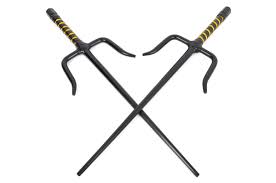
Sai Traditional Martial Arts Weapon
The Sai, often associated with Okinawan martial arts, traces its origins to China and Southeast Asia, evident in ancient versions found in China and forms/Kata within Chinese arts like Kung Fu. Despite its similarity to a short sword, the Sai is not bladed; its three-pronged design includes a traditionally blunt end. Metal scarcity in Okinawa during its historical use makes it unlikely that it was a variation of a farming tool. The Sai was developed in Asia but is associated mainly with Japanese martial arts such as Karate and Okinawan Kobudo.
The Sai’s length is tailored to the user’s forearm, and its two shorter prongs are utilized for trapping and, at times, breaking other weapons like swords or bo. The nunti sai or manji sai form features the two shorter prongs pointing in opposite directions, resembling the swastika kanji.
In ancient Japan, a variation called the Jutte served as a tool for the feudal police to disarm and control criminals. Unlike the Sai, the Jutte was a single weapon, often referred to as the sword breaker. Both the Sai and Jutte are highly effective at trapping swords and other weapons between their prongs. A skilled user can even snap a sword blade using the Sai.
The Sai practiced in your system is from the Shinpo Mataoshi system, with forms and related pairs work structured similarly to Ippon Kumite in the empty-hand art. This integration showcases the adaptability of Sai techniques within a broader martial arts context.
The Sai practiced is from the Shinpo Mataoshi system.
Form and related pairs work structured as Ippon Kumite in the empty hand art.
- Yoku – These are the two shorter prongs that extend from the handle. They form a sort of ‘guard’.
- Tsuka – This is the handle of the Sai. It is e generally wrapped in leather or similar material.
- Monouchi – This is the shaft of the Sai. It can be round, hexagonal, or octagonal. Round Sai are best for demonstration and octagonal Sai are better for training against other martial arts weapons.
- Moto – This is where the Yoku and Monouchi converge. This component is usually a sort of round node.
- Saki – This is the tip of the Sai. The tip is usually blunt and not pointed (as Sai are non-lethal weapons).
Sensei Pete Halloran is our Okinawan weapons instructor who also holds a position on the Shizendo Technical Committee overseeing standards in our Organization.